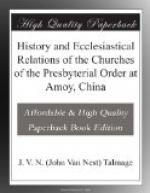So far as the preamble and resolutions of the Synod of 1857 embody the doctrines, and what we supposed to be the policy of our Church, we heartily agreed with them. Of course we were pained to see that they implied, that, in organizing a Church at Amoy, we had not proceeded according to the order of our Church, or had found great difficulty in doing so. This was altogether a mistake, and was already producing evil results. We think there is another mistake in the preamble. It seems small, but because of this fact, and of its plausibility, it has done more, perhaps, than anything else in leading our Church into the false position which she seems now to occupy. Therefore, we should examine it with some care. It is the assumption, as a matter of course, that, “the converts at Amoy” are “an integral part of our Church,” in this country. What made them so? Is it because they were converted through the instrumentality of the preaching of our Missionaries? This is a new doctrine, that a convert as a matter of course belongs to the Church of the preacher through whose instrumentality he has been led unto Christ. Perhaps it was the doctrine of some of the Corinthians, when they said, “I am of Paul, and I of Apollos,” &c., but it was not the doctrine of the Apostle who reproved them. Besides this, how shall we know which of them were converted through our instrumentality? The English Presbyterian brethren and ourselves have preached indiscriminately. Is it because they were baptized by our Missionaries? But many of them were baptized by the English Presbyterian brethren. They have baptized in our churches, and we in theirs. If they be an integral part of the Dutch Church in America, they are also an integral




